Browsing News Entries
More than 3 million people attended Vatican audiences and ceremonies in 2025
Posted on 12/30/2025 18:56 PM (CNA Daily News - Vatican)
 Aerial view of St. Peter’s Square filled with thousands of mourners including clergy and dignitaries gathered for Pope Francis’ funeral Mass under a clear blue sky on April 26, 2025, in Vatican City. | Credit: Daniel Ibáñez/EWTN News
Aerial view of St. Peter’s Square filled with thousands of mourners including clergy and dignitaries gathered for Pope Francis’ funeral Mass under a clear blue sky on April 26, 2025, in Vatican City. | Credit: Daniel Ibáñez/EWTN News
Dec 30, 2025 / 15:56 pm (CNA).
During the year 2025, the participation of the faithful in audiences and liturgical celebrations at the Vatican reached a total of 3,176,620 people.
The Vatican released on Dec. 30 the attendance figures for liturgical celebrations in 2025, a year marked by the Jubilee of Hope, the death of Pope Francis, and the election in May of Pope Leo XIV.
Under the pontificate of Pope Francis, who died on April 21, a total attendance of 262,820 faithful was recorded. The largest crowds were at the Angelus, with 130,000 people, followed by the liturgical celebrations, which drew 62,000 faithful.
The general and jubilee audiences were attended by 60,500 people, while the total for special audiences was 10,320. The months with the highest attendance were January and February, especially for the Angelus and liturgical celebrations.
Pope Francis did not preside over any ceremonies or hold any meetings or audiences during the month of March due to his extended stay at Gemelli Hospital in Rome.
For Pope Leo XIV’s pontificate, which began on May 8, a total of 2,913,800 faithful attended various events. General and jubilee audiences had the greatest participation, drawing 1,069,000 people, followed by the Angelus, with 900,000 in attendance, and liturgical celebrations, which drew 796,500 faithful.
Special audiences brought together 148,300 people. The months with the highest attendance were September, October, and December, with October standing out for the large number of attendees at general audiences.
This story was first published by ACI Prensa, CNA’s Spanish-language news partner. It has been translated and adapted by CNA.
Pope Leo XIV warns against gambling, which ‘ruins many families’
Posted on 12/30/2025 13:45 PM (CNA Daily News - Vatican)
 Credit: Zolnierek/Shutterstock
Credit: Zolnierek/Shutterstock
Dec 30, 2025 / 10:45 am (CNA).
Pope Leo XIV warned about the danger that gambling poses to many families during a Dec. 29 audience with members of the National Association of Italian Municipalities.
At the beginning of his address, delivered in the Apostolic Palace of the Vatican, the Holy Father explained that “the incarnation of the Son of God brings us face to face with a child, whose gentle fragility is in stark contrast to the crushing power of King Herod.”
In this context, he emphasized that “the massacre of the innocents ordered by him not only represents a loss of a future for society but is also a manifestation of an inhuman power that does not know the beauty of love because it disregards the dignity of human life.”
On the contrary, the pope explained that the birth of the Lord “reveals the most authentic aspect of all power, which is above all responsibility and service,” and noted that all authority must “embody the virtues of humility, honesty, and communion.”
The pontiff thus alluded to the public commitment of the Italian association, reminding them of the importance of listening “as a social dynamic that activates these virtues,” specifically “to the needs of families and individuals, especially caring for the most vulnerable, for the good of all.”
Pope Leo XIV focused his attention on certain realities that require special attention, such as the difficulties faced by families and young people as well as the loneliness of the elderly and the “silent cry of the poor.”
In this regard, he emphasized that “our cities are not anonymous places but rather faces and stories that must be safeguarded like precious treasures.”
He also quoted Venerable Giorgio La Pira, known as “the holy mayor” of Florence, who maintained that his fundamental duty was to care for and alleviate anyone who was suffering. In this way, the pope stated that “social cohesion and civic harmony require, first and foremost, listening to the least among us and the poor.”
He then urged the members of the National Association of Italian Municipalities to “become models of dedication to the common good, fostering a social alliance for hope.”
Problem of gambling addiction
After lamenting that cities are experiencing forms of marginalization, violence, and loneliness “that demand to be addressed,” Pope Leo specifically warned against gambling, “which ruins many families.” Citing the latest report from Caritas Italy, he emphasized that this type of gambling addiction is a “serious problem of education, mental health, and social trust.”
“We cannot forget other forms of loneliness from which many people suffer: mental disorders, depression, cultural and spiritual poverty, and social abandonment. These are signs that indicate how much hope is needed. To bear witness to it effectively, politics is called to forge authentically human relationships among citizens, promoting social peace,” the pontiff said.
He also urged that administrative activity promote “the talents of individuals, giving cultural and spiritual depth to cities.”
At the end of his address, he asked the members of the association to have “the courage to offer hope to the people, planning together the best future for their lands, in the logic of integral human development.”
This story was first published by ACI Prensa, CNA’s Spanish-language news partner. It has been translated and adapted by CNA.
Vatican says close to 3 million people saw Pope Leo at the Vatican in 2025
Posted on 12/30/2025 07:30 AM (USCCB News Releases)
VATICAN CITY (CNS) -- Close to 3 million pilgrims and visitors attended audiences, liturgies or meetings at the Vatican with Pope Leo XIV from the time of his election in May through December, according to the Prefecture of the Papal Household.
The prefecture, which handles the free tickets to audiences and Masses, as well as arranges the pope's daily schedule of meetings, published statistics for the year Dec. 30.
The numbers did not include events outside the Vatican -- for instance, it did not count the Mass with more than 1 million people the pope celebrated Aug. 3 at Tor Vergata on the outskirts of Rome to conclude the Jubilee of Youth, nor did the tabulations include the crowds who came to see him in Turkey and Lebanon during his first foreign trip as pope Nov. 27-Dec. 2.
The prefecture did include people who came to see Pope Francis before his death April 21. The pope, who was hospitalized from Feb. 14 to March 23, was present for eight Wednesday or Jubilee general audiences at the Vatican, welcoming 60,500 people.
In special audiences with groups, Pope Francis encountered more than 10,000 people; some 62,000 people joined Pope Francis for Masses and prayer services and an estimated 130,000 joined him for the midday recitation of the Angelus prayer on Sundays, the prefecture said. That means he encountered 262,820 people in 2025.
Pope Leo held 36 general and Jubilee audiences during the year since his election May 8, encountering just over 1 million people, the prefecture reported.
In special audiences with smaller groups, the office said, he met with another 148,300 people.
Some 796,500 people attended liturgies celebrated by Pope Leo at the Vatican during the year, and an estimated 900,000 people joined him for the recitation of the Angelus on Sundays and holy days.
The prefecture said that meant 2,913,800 people had encountered Pope Leo at the Vatican in 2025.
The total for 2024, which was not a Holy Year, was close to 1.7 million people at audiences and prayers with Pope Francis.
PHOTOS: Unforgettable moments from the 2025 papal transition
Posted on 12/30/2025 04:00 AM (CNA Daily News - Vatican)
 A view of the coffin of Pope Francis resting before the altar at the funeral Mass on St. Peter’s Square, April 26, 2025. - Credit: Daniel Ibáñez/CNA
A view of the coffin of Pope Francis resting before the altar at the funeral Mass on St. Peter’s Square, April 26, 2025. - Credit: Daniel Ibáñez/CNA
Vatican City, Dec 30, 2025 / 01:00 am (CNA).
2025 began with Catholics around the world uniting in prayer for Pope Francis’ health as he entered the hospital on Feb. 14. He was admitted to Gemelli Hospital in Rome for a respiratory infection that progressed to bilateral pneumonia, requiring a prolonged hospitalization that lasted almost six weeks.
Soon after, on March 29, the pontiff was readmitted into the hospital with difficulty breathing. On April 21, the day after Easter, Pope Francis passed away at the age of 88 from a stroke, coma, and irreversible cardiovascular collapse, according to the death certificate published just over 12 hours after his death.
On April 26, more than 400,000 people filled St. Peter’s Square for the funeral of Pope Francis as the world said goodbye to the first Latin American pope who led the Catholic Church for 12 years.
Then on May 7, 133 cardinal electors gathered from all corners of the globe in the Sistine Chapel for the start of the conclave to elect a new pope. After four ballots, Cardinal Robert Prevost was elected on May 8 as the 267th bishop of Rome and leader of the Catholic Church. He took the name Pope Leo XIV. A Chicago native, he became the first American pope in Church history.
Here are some of the most impactful images from the papal transition — beginning with Pope Francis’ last general audience before being admitted to the hospital, the start of the conclave, and the election of Pope Leo:

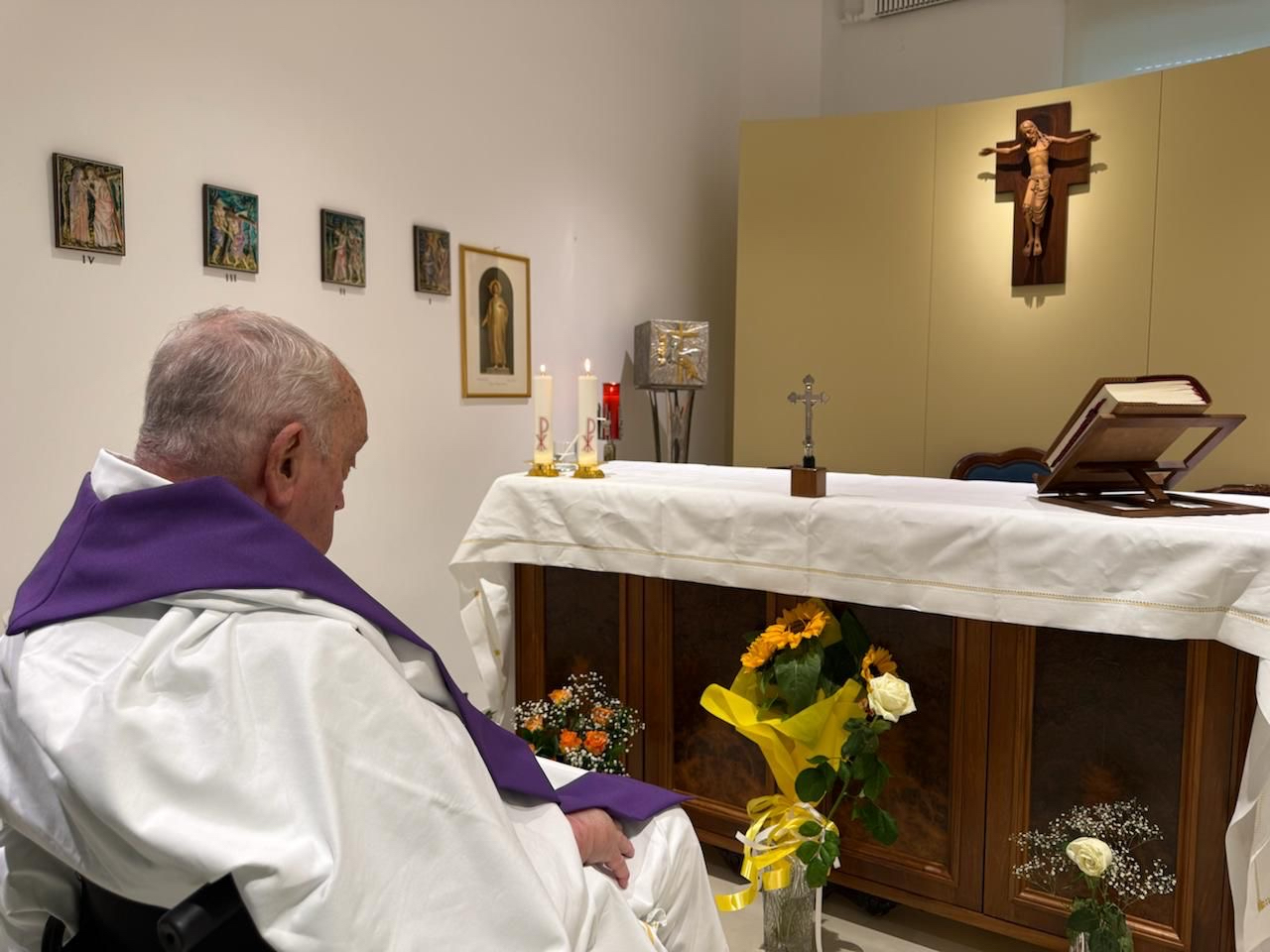

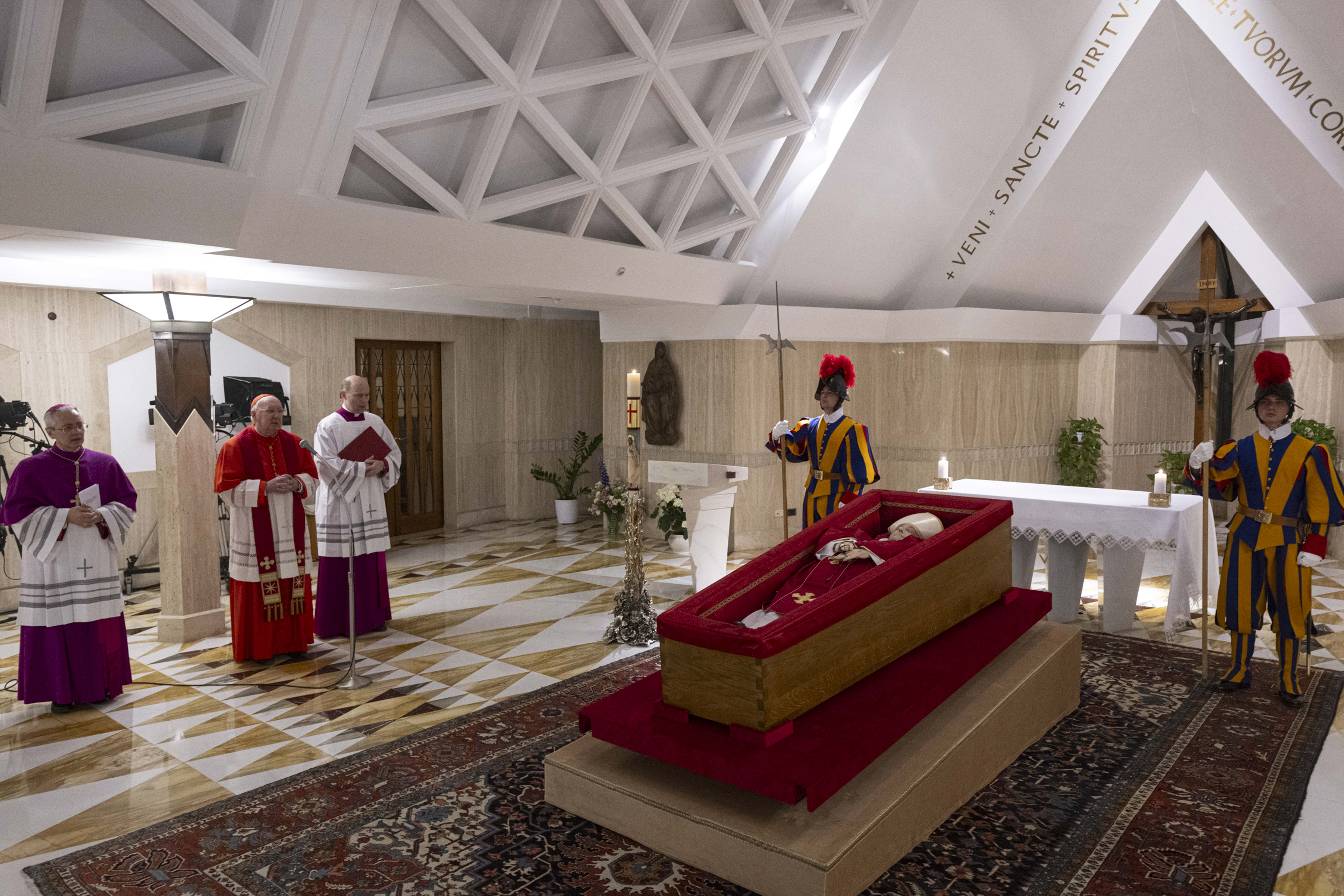

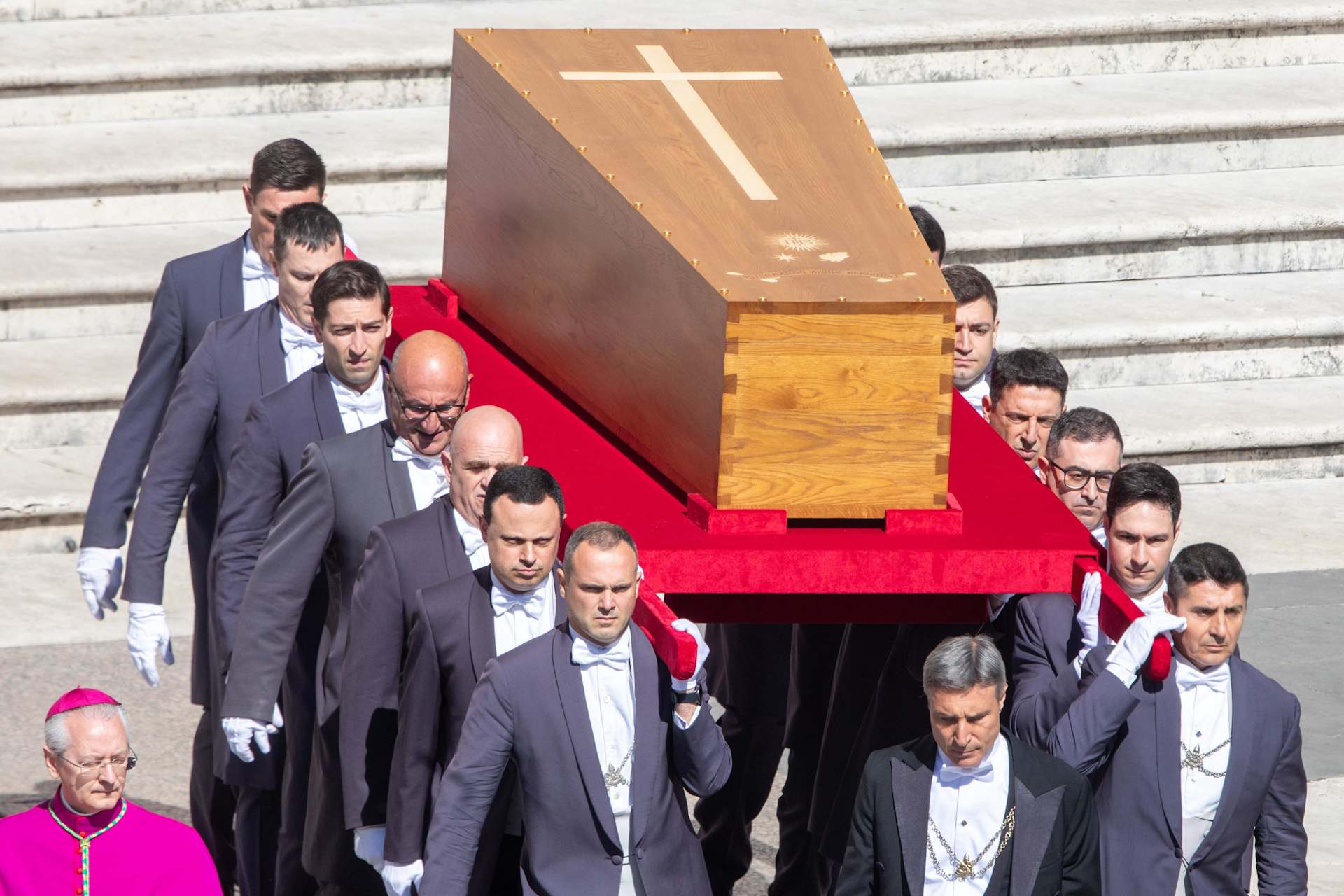


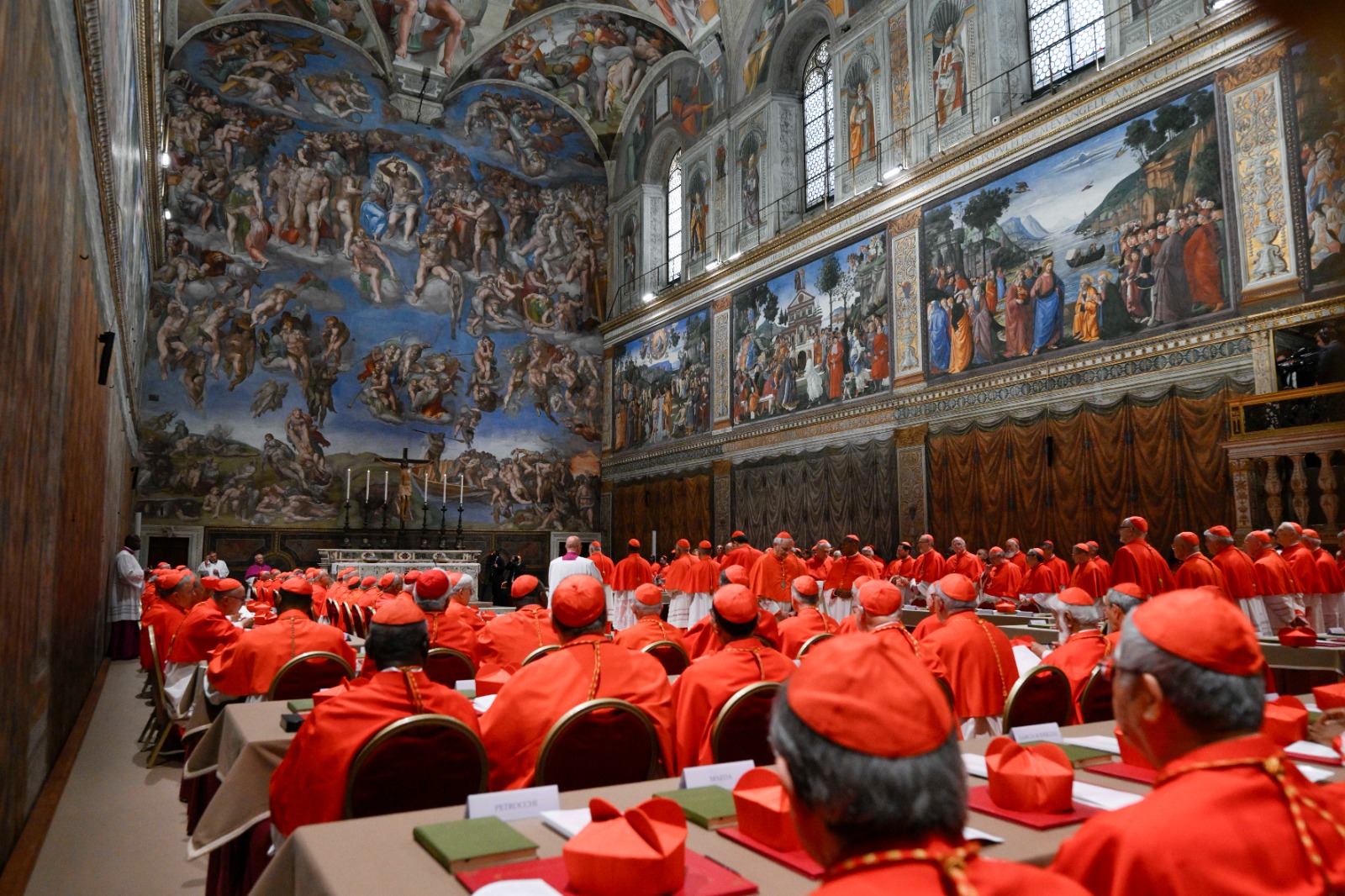
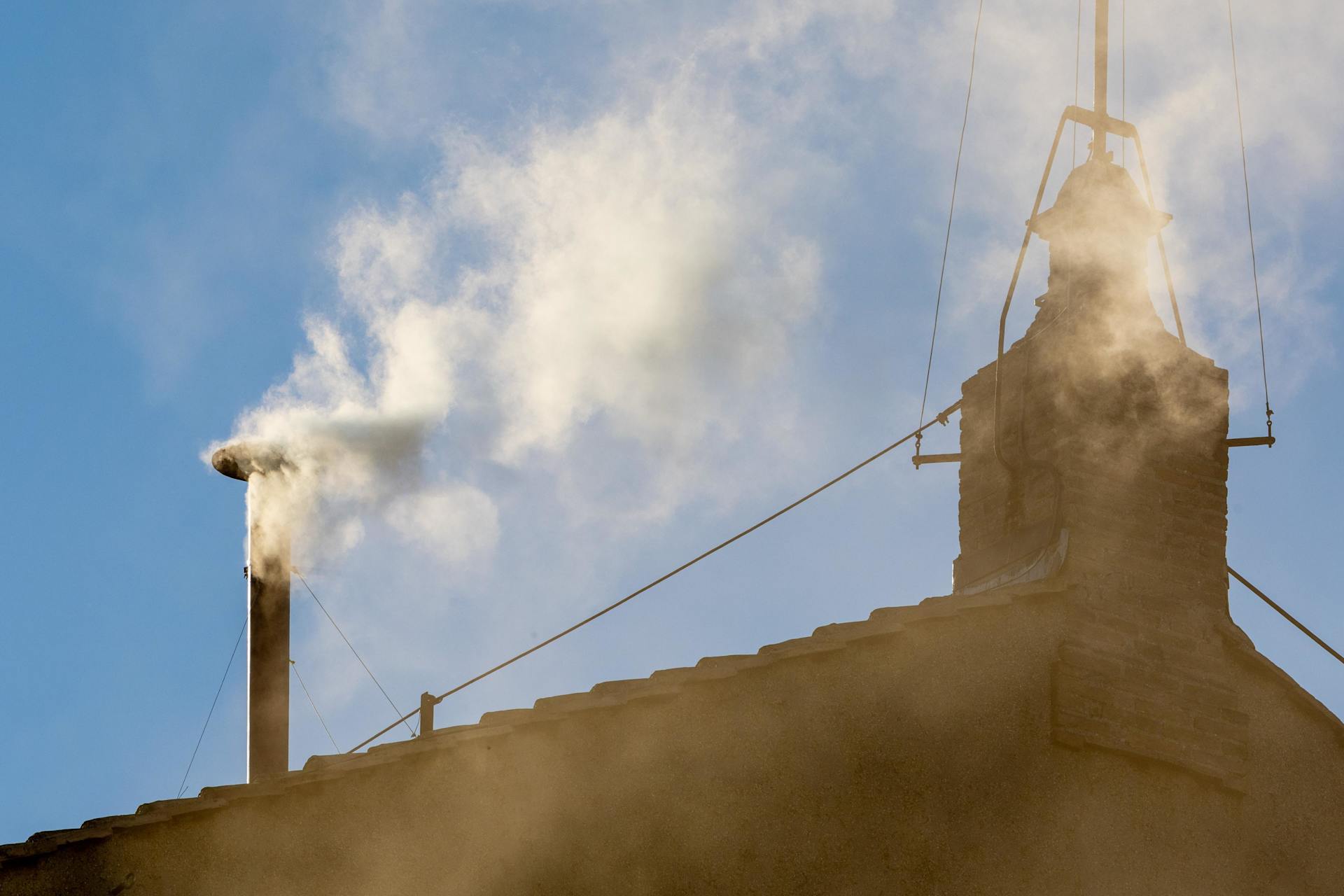
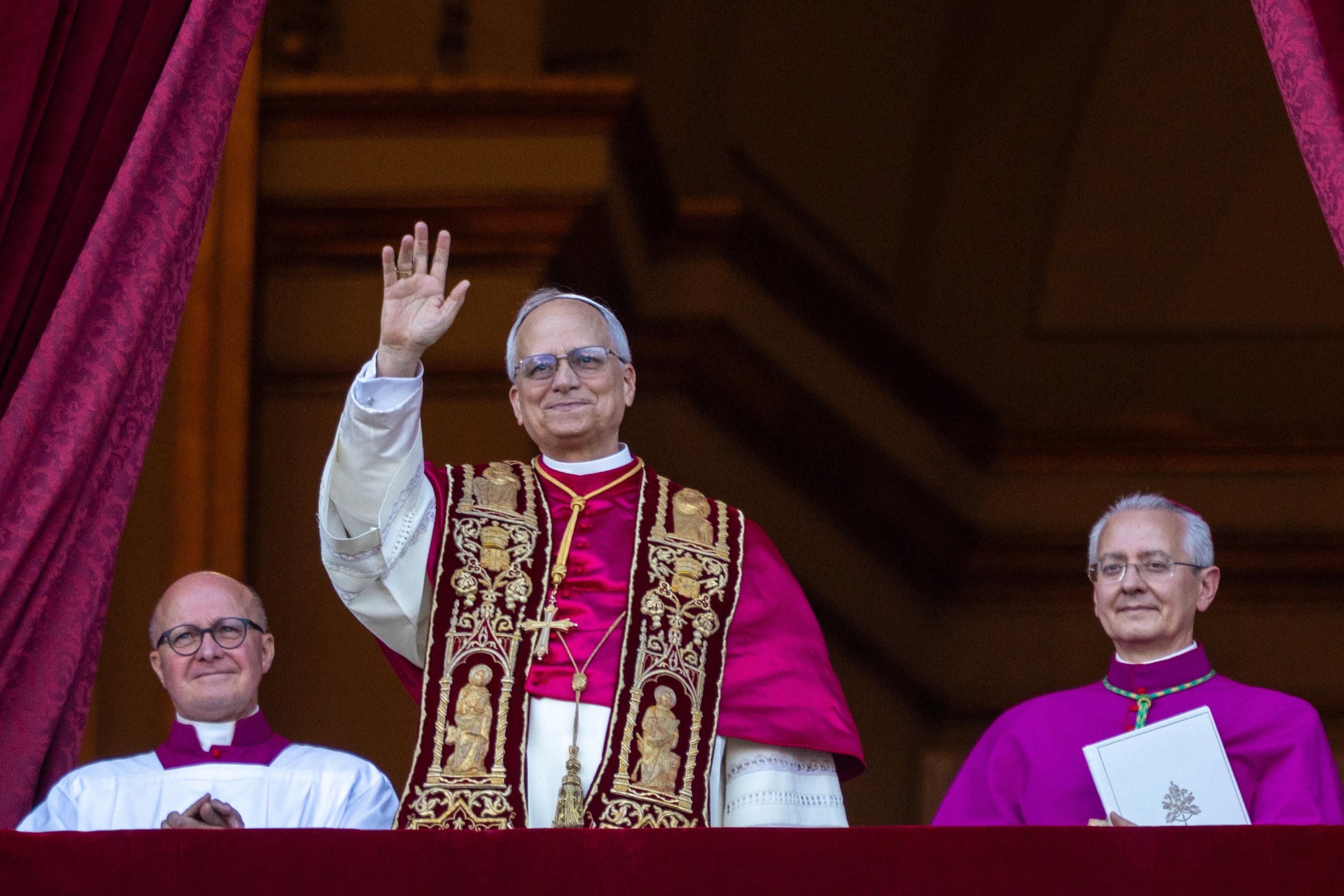
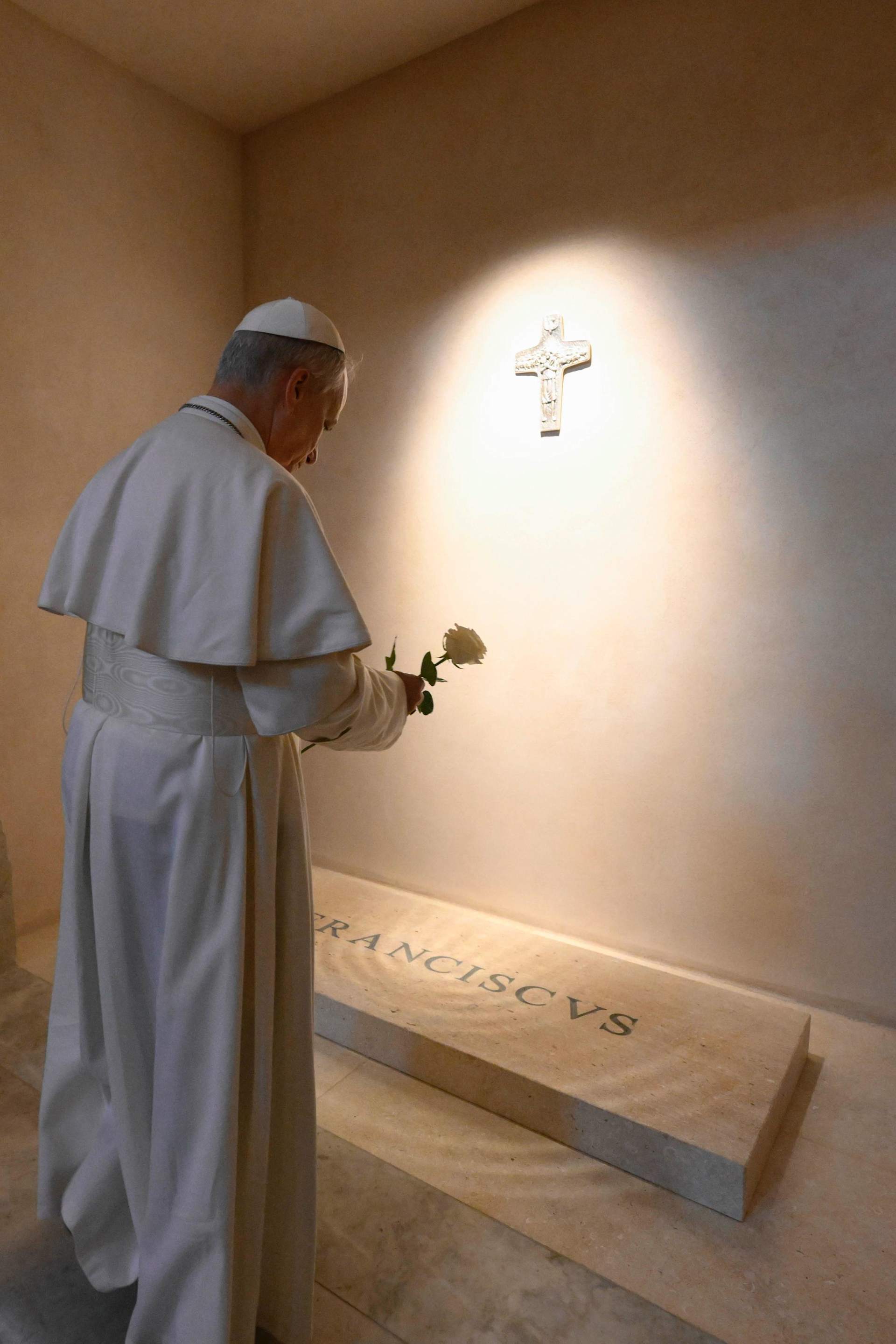

Pope Leo XIV: To let God work in your life, you have to empty yourself
Posted on 12/29/2025 17:48 PM (CNA Daily News - Vatican)
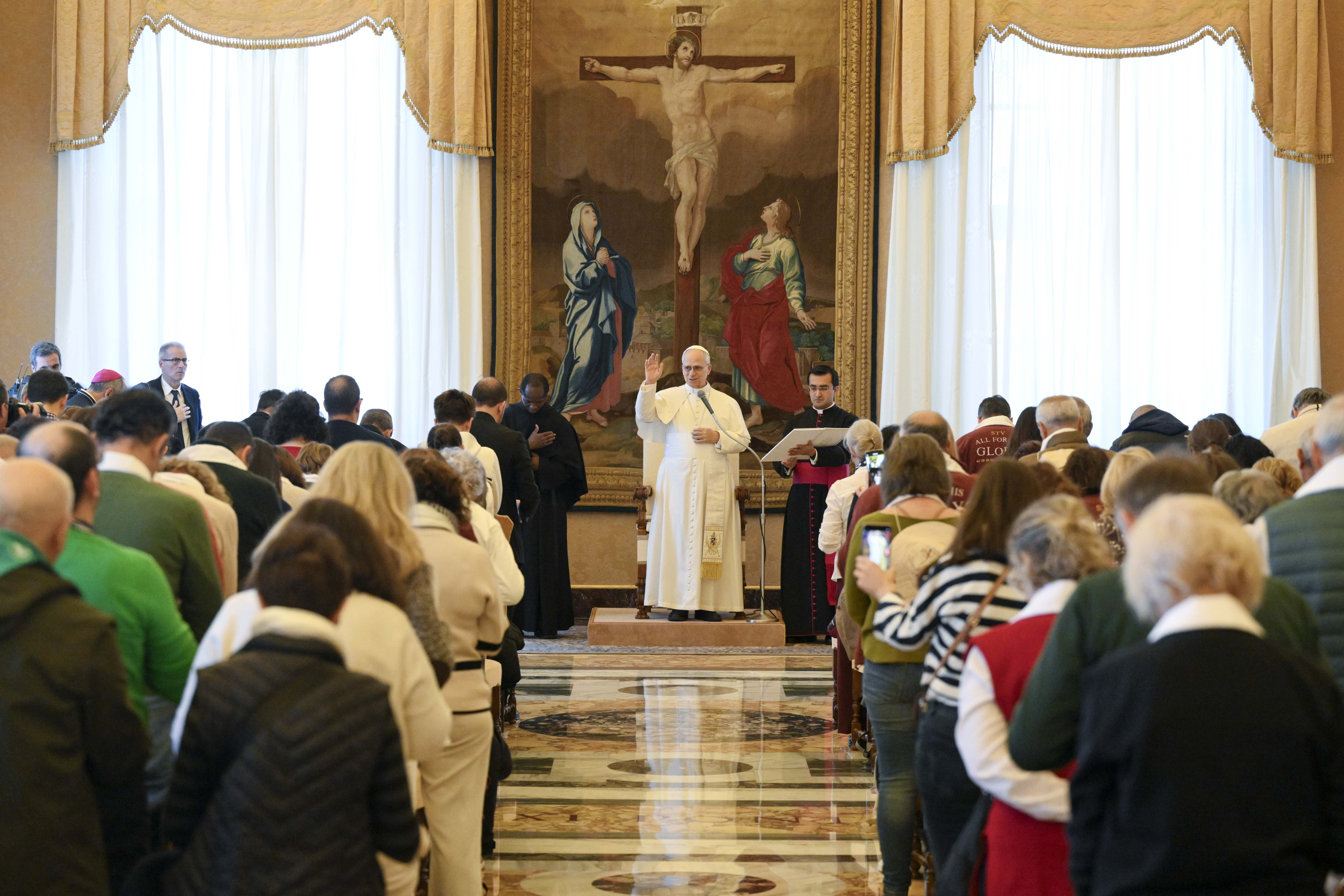 Pope Leo XIV meets with a group of pilgrims from St. Thomas of Villanova Parish in Alcalá de Henares, Spain, on Dec. 29, 2025, in the Apostolic Palace at the Vatican. | Credit: Vatican Media
Pope Leo XIV meets with a group of pilgrims from St. Thomas of Villanova Parish in Alcalá de Henares, Spain, on Dec. 29, 2025, in the Apostolic Palace at the Vatican. | Credit: Vatican Media
Dec 29, 2025 / 14:48 pm (CNA).
Pope Leo XIV on Monday explained that in order to allow God’s action in our personal lives, people must “empty” themselves and cultivate a deep inner life.
The pontiff made the observation during a Dec. 29 audience at the Apostolic Palace with a group of pilgrims from St. Thomas of Villanova Parish in Alcalá de Henares, Spain.
The event took place in the context of the Jubilee Year of Hope, which the Holy Father described as “a particularly significant time for the Church.” Leo XIV thanked the pilgrims for their spiritual closeness and support for the successor of Peter “with their prayers and generosity,” emphasizing that this is “a gesture of communion and closeness.”
In his greeting, the pope recalled the figure of St. Thomas of Villanova, an Augustinian Spanish bishop and the patron saint of the pilgrims’ parish, highlighting that he was a man “open to God’s action in his life.”
“That openness led him to do much good,” Pope Leo said.
The pontiff invited the faithful to be inspired by some of the distinctive traits of the Spanish saint, beginning with his intense spiritual life.
Recognize talents, put them at service of community
“In his life and in his writings, he reveals to us an unceasing search for continuous prayer; that is, a holy restlessness to be in God’s presence at every moment,” he said. This attitude involves profound interiority, emptying yourself to listen to and allow the Lord to work.”
Leo XIV also highlighted the saint’s “sobriety and simplicity” as well as “his selfless labor,” especially in the university setting, and his “apostolic zeal.” The pope emphasized that all these attitudes lead us to believe that “we must recognize the talents we have received and put them at the service of the community, with effort and dedication, so that they may multiply for the benefit of all,” especially in a world that “seems to offer us everything more and more quickly and easily.”
He also highlighted the simplicity of St. Thomas of Villanova (1486–1555), historically known as the “Archbishop of the Poor” or the “Almsgiver of God” because of his immense charity. “I would like to emphasize his love for the poor,” he said.
Referring to the parish life of the pilgrims, Leo XIV expressed his gratitude for their concrete sensitivity toward those most in need, reminding them that “the poor are not only someone to be helped but the sacramental presence of the Lord.”
This story was first published by ACI Prensa, CNA’s Spanish-language news partner. It has been translated and adapted by CNA.
As Holy Doors close, cardinals emphasize God's arms are always open
Posted on 12/29/2025 07:30 AM (USCCB News Releases)
ROME (CNS) -- The path to conversion, the door to God's mercy and the call to live in Christian hope all continue beyond the Jubilee Year, said the three cardinals who closed the Holy Doors at three major basilicas in Rome.
On the feast of the Epiphany, Jan. 6, Pope Leo will solemnly close the Holy Door of St. Peter's Basilica at the Vatican, formally concluding the Holy Year 2025, which Pope Francis opened on Christmas Eve 2024. But diocesan and other local celebrations of the Jubilee concluded Dec. 28.
Cardinal Rolandas Makrickas, archpriest of Rome's Basilica of St. Mary Major, presided over the rite of closing the basilica's Holy Door at dusk Dec. 25 before celebrating a special Mass. Cardinal Baldassare Reina, papal vicar of Rome and archpriest of the Basilica of St. John Lateran, did the same there Dec. 27. And U.S. Cardinal James M. Harvey, archpriest of the Basilica of St. Paul Outside the Walls, presided over the closing of its Holy Door and the celebration of Mass Dec. 28.
The Holy Doors are bricked up between Jubilee Years, which usually occur every 25 years. Pope Leo has indicated, however, that an extraordinary Holy Year will be celebrated in 2033, to mark the 2,000th anniversary of the death and resurrection of Jesus.
"What is closing is not divine grace, but a special time of the church, and what remains open forever is the heart of the merciful God," Cardinal Makrickas said in his homily Dec. 25. While the Holy Door is closed, "the door that truly matters remains that of our heart: it opens when it listens to the word of God, it widens when it welcomes our brother or sister, it is strengthened when it forgives and asks for forgiveness,” he said.
"In this basilica, precisely during this Holy Year, we have been granted the grace of a very special task: to safeguard a memory that becomes prophecy," he said, drawing attention to the late Pope Francis, who is buried at St. Mary Major "and honored by thousands of faithful every day."
According to SIR, the news agency of the Italian bishops' conference, an estimated 20 million pilgrims passed through the Holy Door at the basilica in the past year.
Hope, the theme of the Jubilee Year, "moved the countless pilgrims who left on our roads the footprints of steps weighed down by the burdens pressing upon their hearts," Cardinal Reina told people during the Mass at St. John Lateran. "They passed through the Holy Door in order to find the One they were seeking. The door of our cathedral bears the imprints of the caresses of all those who passed through it in search of mercy."
Though the Holy Door is closed, he said, "we know that the Risen One passes through closed doors and never tires of knocking on our closed doors, in order to offer and to find mercy. Yes, to find it -- because he too seeks it."
"Indeed, he has told us of the final surprise: that in the end we will be judged on love, on mercy, on the glass of water given to the thirsty; on the morsel of bread to the hungry; on closeness to those who are imprisoned or ill; on clothing the naked; on welcoming the stranger," Cardinal Reina said.
At St. Paul Outside the Walls, the burial place of the Apostle Paul, Cardinal Harvey noted that the Jubilee's theme, "Hope does not disappoint," was taken from St. Paul's Letter to the Romans. "It is not only a motto, but is most of all a profession of faith," the cardinal said.
"In a world marked by war, crises, injustices and confusion, the church wanted to reaffirm that Christian hope is far different from trying to flee history," he said; rather, "it is expressed in the ability to pass through it with one's gaze fixed on Christ."
The Holy Door is not simply a material passageway, Cardinal Harvey said, "it is a spiritual threshold, a call to each one of us to leave behind that which weighs on our hearts to enter the space of mercy. Crossing it means recognizing that salvation flows from humbly entrusting ourselves to the only One who can give us fullness of life."
Pope Leo XIV sends 3 truckloads of humanitarian aid to Ukraine
Posted on 12/28/2025 12:00 PM (CNA Daily News - Vatican)
 Pope Leo XIV addresses pilgrims gathered in St. Peter’s Square at the Vatican for recitation of the Angelus on Dec. 28, 2025. | Credit: Vatican Media
Pope Leo XIV addresses pilgrims gathered in St. Peter’s Square at the Vatican for recitation of the Angelus on Dec. 28, 2025. | Credit: Vatican Media
Vatican City, Dec 28, 2025 / 09:00 am (CNA).
Pope Leo XIV has sent three trucks carrying humanitarian aid to parts of Ukraine hit hardest by bombardments, where residents are facing severe shortages of electricity, water, and heat.
Cardinal Konrad Krajewski, the pope’s almoner, disclosed the delivery to Vatican media on Dec. 27, saying the convoy carried special food that can be dissolved in a small amount of water to produce energy-rich soups with chicken and vegetables.
Krajewski described the shipment as a small gesture of closeness from the pope to Ukrainian families on the feast of the Holy Family, celebrated Dec. 28.
The trucks, he said, arrived in the Vatican shortly before Christmas loaded with supplies donated by South Korean food company Samyang Foods. As had happened on previous occasions, including during the pontificate of Pope Francis, the aid was then redirected to war zones most severely affected by strikes, where basic utilities are often unavailable.
Krajewski said the delivery underscores that the pope not only prays for peace but also wants to be concretely present with families who are suffering.
This story was first published by ACI Prensa, CNA’s Spanish-language news partner. It has been translated and adapted by CNA.
Pope Leo XIV urges families to keep the flame of love alive
Posted on 12/28/2025 11:30 AM (CNA Daily News - Vatican)
 Pope Leo XIV greets pilgrims gathered in St. Peter’s Square at the Vatican for the recitation of the Angelus on Dec. 28, 2025. | Credit: Vatican Media
Pope Leo XIV greets pilgrims gathered in St. Peter’s Square at the Vatican for the recitation of the Angelus on Dec. 28, 2025. | Credit: Vatican Media
Vatican City, Dec 28, 2025 / 08:30 am (CNA).
Pope Leo XIV on Sunday urged Christian families to “cherish the values of the Gospel” and protect the “flame of love” in their homes against modern myths of success, power, and comfort that he said often leave people isolated and divided.
Speaking to pilgrims in St. Peter’s Square before the Angelus on Dec. 28, the feast of the Holy Family of Nazareth, the pope reflected on the Gospel account of the family’s flight into Egypt and contrasted the trust of Jesus, Mary, and Joseph with what he called the fear-driven cruelty of King Herod.
“It is a moment of trial for Jesus, Mary, and Joseph,” Leo said, adding that “the bright image of Christmas is suddenly almost eclipsed by the disturbing shadow of a deadly threat.”
The pope described Herod as “a cruel and bloodthirsty man” who is “deeply lonely and gripped with the fear of being deposed.” After hearing from the Magi that the “king of the Jews” had been born, Herod “decrees that all children of the same age as Jesus should be killed,” the pope said.
“In Bethlehem there is light and joy,” Leo noted, recalling the shepherds who “have glorified God before the manger,” but he said “none of this can penetrate the armored defenses of the royal palace, except as a distorted echo of a threat to be stifled with blind violence.”
Against that backdrop, the pope said the Holy Family reveals “the only possible answer of salvation,” namely, “God who, in total gratuitousness, gives himself to men without reserve and without pretension.”
Leo pointed to St. Joseph’s obedience in protecting Mary and Jesus, saying that “the gesture of Joseph is revealed in all its redemptive significance.” He added: “In Egypt, the flame of domestic love, to which the Lord has entrusted his presence in the world, grows and gains strength in order to bring light to the whole world.”
Turning to families today, the pope warned that “the world always has its ‘Herods,’ its myths of success at any cost, of unscrupulous power, of empty and superficial well-being” and said societies often “pay the price in the form of loneliness, despair, divisions, and conflicts.”
“Let us not allow these mirages to suffocate the flame of love in Christian families,” he said.
Instead, Leo urged families to cultivate “prayer, frequent reception of the sacraments, especially confession and Communion, healthy affections, sincere dialogue, fidelity, and the simple and beautiful concreteness of everyday words and gestures.” He said such family life can make homes “a light of hope for the places in which we live; a school of love and an instrument of salvation in God’s hands.”
After the Angelus, the pope greeted pilgrims from several Italian parishes and groups. He also renewed his appeal for peace, asking Catholics to remember those suffering because of conflict.
“In the light of the Nativity of the Lord, let us continue to pray for peace,” he said. “Today, in particular, let us pray for families suffering because of war, especially for children, elderly, and the most vulnerable.”
This story was first published by ACI Prensa, CNA’s Spanish-language news partner. It has been translated and adapted by CNA.
Pope Leo XIV: Christians have no enemies, only brothers and sisters
Posted on 12/26/2025 05:17 AM (CNA Daily News - Vatican)
 Pope Leo XIV addresses pilgrims gathered in St. Peter’s Square at the Vatican for the recitation of the Angelus on Dec. 26, 2025. | Credit: Vatican Media
Pope Leo XIV addresses pilgrims gathered in St. Peter’s Square at the Vatican for the recitation of the Angelus on Dec. 26, 2025. | Credit: Vatican Media
Vatican City, Dec 26, 2025 / 02:17 am (CNA).
Pope Leo XIV on Friday urged Christians to resist the temptation to treat others as enemies, saying the mystery of Christmas calls believers to recognize the God-given dignity of every person, even in their adversaries.
“Christians, however, have no enemies, but brothers and sisters, who remain so even when they do not understand each other,” the pope said Dec. 26 during his Angelus address from the Apostolic Palace on the feast of St. Stephen, the Church’s first martyr.
Leo acknowledged that “those who believe in peace and have chosen the unarmed path of Jesus and the martyrs are often ridiculed, excluded from public discourse,” and sometimes even “accused of favoring adversaries and enemies.” Yet, he said Christian joy is sustained by “the tenacity of those who already live in fraternity.”
Reflecting on St. Stephen’s martyrdom, the pope noted that early Christians spoke of the saint’s “birthday,” convinced “that we are not born just once” and that “martyrdom is a birth into heaven.”
Citing the Acts of the Apostles, Leo recalled that those who witnessed Stephen’s trial and death “saw that his face was like the face of an angel” (Acts 6:15), calling it “the face of one who does not leave history indifferently but responds to it with love.”
The pope linked Stephen’s witness to the meaning of Christmas, saying “the birth of the Son of God among us calls us to live as children of God,” drawing believers through the humility of Mary, Joseph, and the shepherds of Bethlehem.
At the same time, he said, the beauty of Christ and of those who imitate him can be rejected because it exposes injustice and threatens those “who struggle for power.”
“To this day, however, no power can prevail over the work of God,” Leo said, pointing to people around the world who choose justice “even at great cost,” who “put peace before their fears,” and who serve the poor.
“In the current conditions of uncertainty and suffering in the world, joy might seem impossible,” he added, but insisted hope still “sprouts” and “it makes sense to celebrate despite everything.”
The pope said Stephen’s final act of forgiveness mirrors Jesus’ own, flowing from “a force more real than that of weapons,” a “gratuitous force” rekindled when people learn to look at their neighbor with “attention and recognition.”
“Yes, this is what it means to be reborn, to come once more into the light, this is our ‘Christmas!’” he said.
After the Angelus, Leo renewed his Christmas wishes “for peace and serenity,” greeted pilgrims in St. Peter’s Square, and asked St. Stephen’s intercession for persecuted Christians and communities suffering for their faith. He also encouraged those working amid conflict to pursue “dialogue, reconciliation, and peace.”
This story was first published by ACI Prensa, CNA’s Spanish-language news partner. It has been translated and adapted by CNA.
Pope Leo XIV highlights Gaza, Yemen, migrants in first Christmas urbi et orbi message
Posted on 12/25/2025 05:00 AM (CNA Daily News - Vatican)
 Pope Leo XIV delivers his Christmas “urbi et orbi” message at the Vatican on Dec. 25, 2025. | Credit: Daniel Ibañez/EWTN News
Pope Leo XIV delivers his Christmas “urbi et orbi” message at the Vatican on Dec. 25, 2025. | Credit: Daniel Ibañez/EWTN News
Vatican City, Dec 25, 2025 / 02:00 am (CNA).
In his first Christmas “urbi et orbi” message as pope, Leo XIV urged the world to embrace “responsibility” as the sure way to peace while pointing in particular to the suffering of people in Gaza, Yemen, and those fleeing war and poverty as refugees and migrants.
Before an estimated 26,000 people gathered in St. Peter’s Square on Dec. 25, the pope appeared at the central balcony of St. Peter’s Basilica to deliver the traditional Christmas blessing “to the city and to the world,” eight months after his May 8 election.
In one of the most evocative passages of the message, the pope cited at length from “Wildpeace,” a poem by Israeli poet Yehuda Amichai, contrasting “the peace of a ceasefire” with a deeper peace that arrives unexpectedly — “like wildflowers” — after exhaustion and conflict.
“Responsibility is the sure way to peace,” Leo said. “If all of us, at every level, would stop accusing others and instead acknowledge our own faults, asking God for forgiveness, and if we would truly enter into the suffering of others and stand in solidarity with the weak and the oppressed, then the world would change.”
The pope framed his appeal around the Christian proclamation that Christ “is our peace,” adding: “Without a heart freed from sin, a heart that has been forgiven, we cannot be men and women of peace or builders of peace.”
Turning to concrete “faces” of contemporary pain, Leo said that in becoming man, Jesus “took upon himself our fragility, identifying with each one of us: with those who have nothing left and have lost everything, like the inhabitants of Gaza; with those who are prey to hunger and poverty, like the Yemeni people; with those who are fleeing their homeland to seek a future elsewhere, like the many refugees and migrants who cross the Mediterranean or traverse the American continent.”
He also named those who have lost jobs, underpaid workers who are exploited, and prisoners “who often live in inhumane conditions.”
Leo offered “a warm and fatherly greeting” to Christians, “especially those living in the Middle East,” recalling his recent trip to Turkey and Lebanon. “I listened to them as they expressed their fears and know well their sense of powerlessness before the power dynamics that overwhelm them,” he said.
“From God let us ask for justice, peace, and stability for Lebanon, Palestine, Israel, and Syria,” the pope continued as he invoked Scripture on righteousness and peace.
He also prayed “in a particular way for the tormented people of Ukraine,” asking that “the clamor of weapons cease” and that the parties involved — “with the support and commitment of the international community” — find “the courage to engage in sincere, direct, and respectful dialogue.”
In a wider survey of global crises, the pope said: “From the Child of Bethlehem, we implore peace and consolation for the victims of all current wars in the world, especially those that are forgotten, and for those who suffer due to injustice, political instability, religious persecution, and terrorism,” naming Sudan, South Sudan, Mali, Burkina Faso, and the Democratic Republic of Congo. He prayed as well for Haiti, asking that “all forms of violence in the country will cease,” and called for a future of reconciliation for Myanmar.
Leo also included a specific appeal for Latin America, asking that “the child Jesus inspire those in Latin America who hold political responsibilities” so that amid the region’s challenges, “space may be given to dialogue for the common good rather than to ideological and partisan prejudices.”
He concluded by urging the faithful to open their hearts to those in need: “On this holy day, let us open our hearts to our brothers and sisters who are in need or in pain,” before offering “heartfelt good wishes for a peaceful and holy Christmas!”
This story was first published by ACI Prensa, CNA’s Spanish-language news partner. It has been translated and adapted by CNA.
